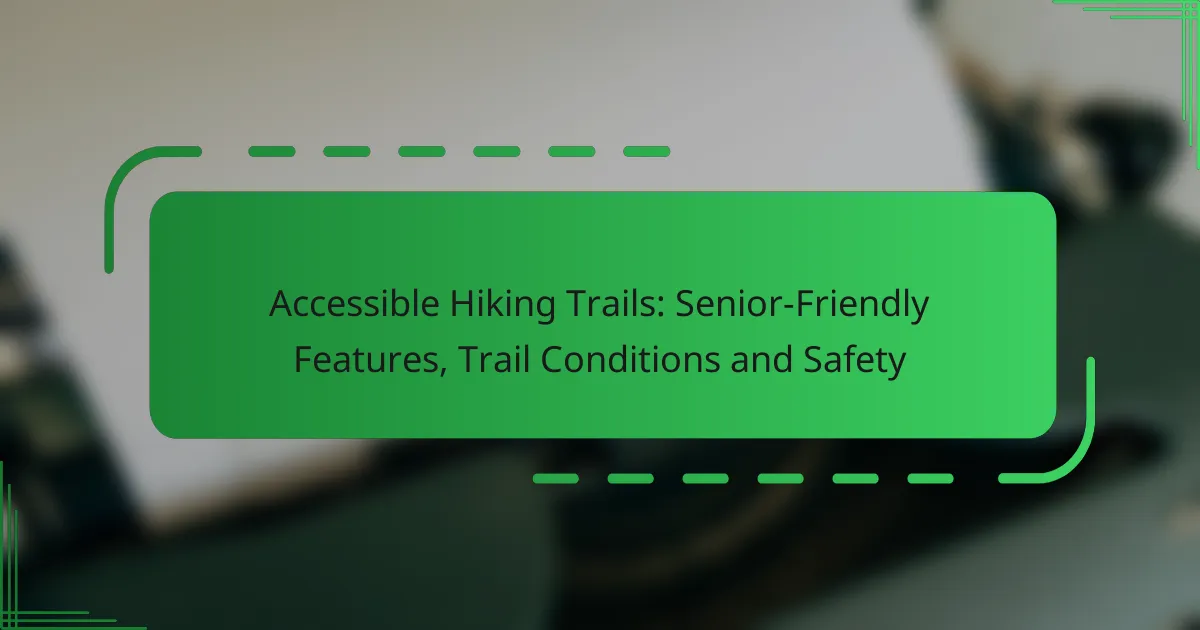Exploring the scenic hiking trails of the United States reveals a wealth of breathtaking waterfalls and stunning vistas, particularly in renowned national parks. From the challenging paths of the Rocky Mountains to more accessible routes, hikers of all skill levels can find trails that suit their preferences. To enhance your experience, it’s essential to stay informed about trail conditions, weather updates, and potential hazards before setting out on your adventure.
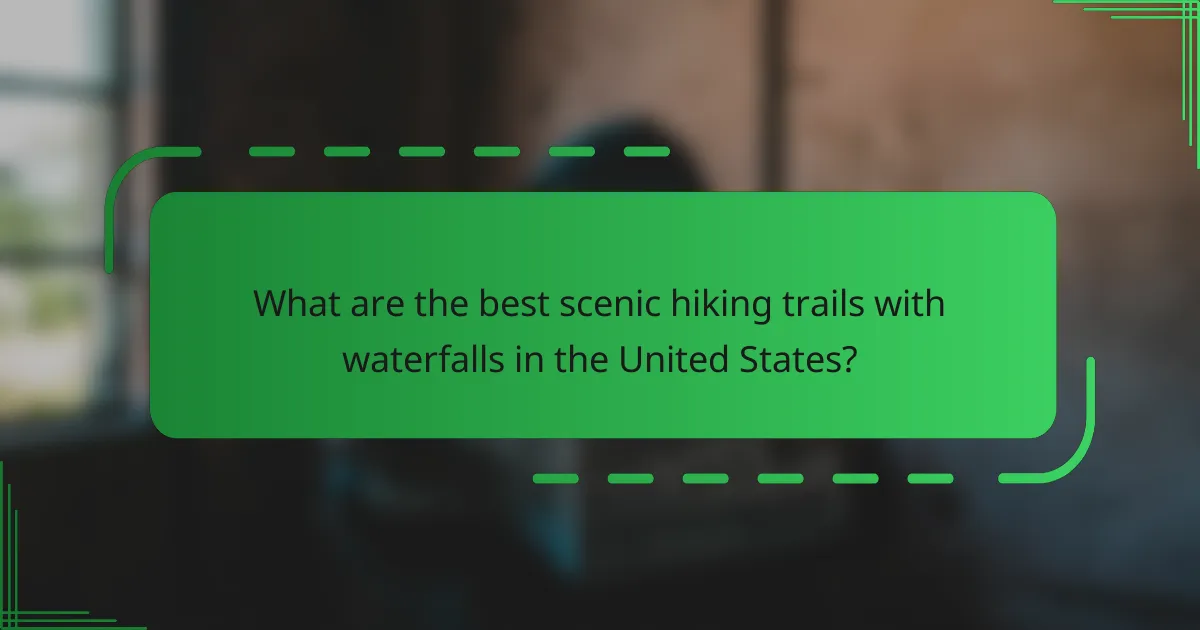
What are the best scenic hiking trails with waterfalls in the United States?
The United States offers numerous scenic hiking trails featuring breathtaking waterfalls. Some of the best trails include those in iconic national parks that provide stunning views and varying trail conditions suitable for different skill levels.
Yosemite National Park: Yosemite Falls Trail
The Yosemite Falls Trail is a renowned hike that leads to one of the tallest waterfalls in North America. The trail spans about 7.2 miles round trip and features steep sections, making it a challenging yet rewarding experience.
As you ascend, expect to encounter breathtaking vistas of the falls and the surrounding granite cliffs. The best time to visit is in late spring when the water flow is at its peak, providing a spectacular view of the cascading water.
Be prepared for variable trail conditions, especially after rain, and ensure you have proper footwear and plenty of water for the hike.
Havasu Falls: Havasupai Trail
The Havasupai Trail leads to the stunning Havasu Falls, known for its turquoise waters and picturesque scenery. This 10-mile trail requires a permit, which can be challenging to obtain due to high demand, so plan ahead.
The hike takes you through a desert landscape before descending into a lush canyon filled with vibrant vegetation. The best time to visit is during spring or fall to avoid the extreme heat of summer.
Camping is available near the falls, but reservations are essential. Ensure you carry enough water and food, as the trail is remote and facilities are limited.
Multnomah Falls: Columbia River Gorge Trail
The Multnomah Falls Trail is a popular hike located in the Columbia River Gorge, featuring the tallest waterfall in Oregon at 620 feet. The trail is relatively short, about 2.4 miles round trip, making it accessible for families and casual hikers.
The path includes a scenic bridge that offers stunning views of the falls and the surrounding lush forest. This area is particularly beautiful in spring when wildflowers bloom and the falls are at their fullest.
Parking can fill up quickly, especially on weekends, so arrive early. The trail is well-maintained, but be cautious of slippery conditions after rain.
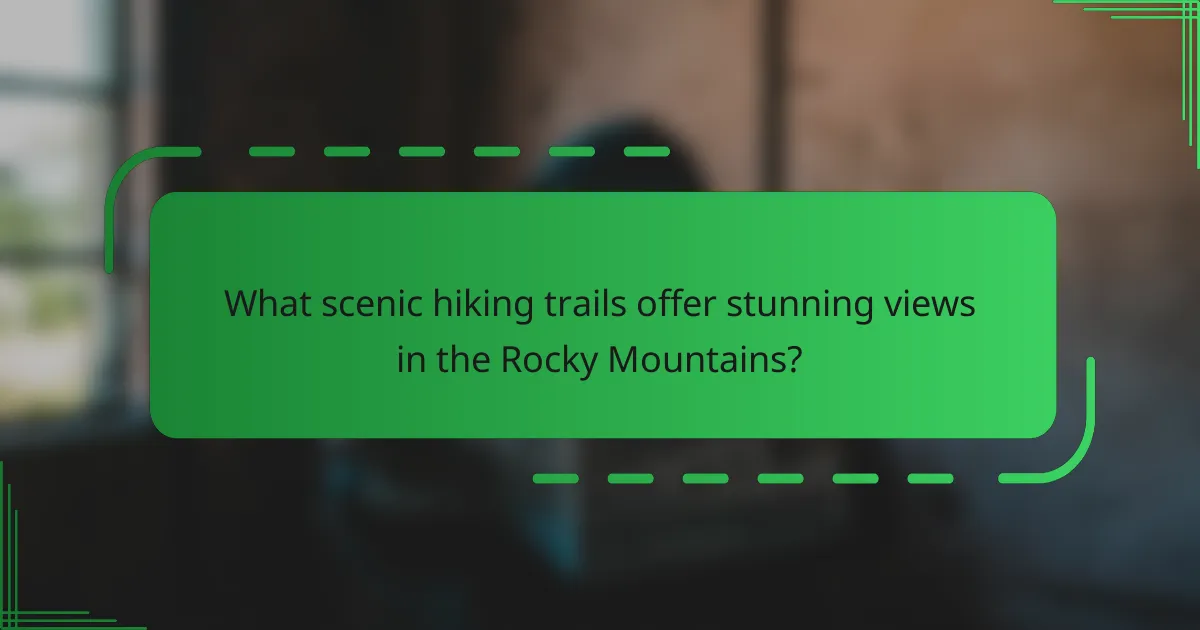
What scenic hiking trails offer stunning views in the Rocky Mountains?
The Rocky Mountains are home to numerous scenic hiking trails that provide breathtaking views. Trails like Longs Peak and Grays Peak offer not only stunning vistas but also unique challenges for hikers seeking adventure.
Longs Peak: Keyhole Route
The Keyhole Route is the most popular trail for reaching the summit of Longs Peak, standing at over 14,000 feet. This challenging hike requires good physical fitness and proper preparation, as it involves steep sections and potential exposure to rapidly changing weather conditions.
Hikers should plan for a full day, typically starting before sunrise to avoid afternoon storms. Essential gear includes sturdy hiking boots, plenty of water, and layers of clothing to adapt to temperature changes. It’s advisable to check trail conditions and weather forecasts before heading out.
Grays and Torreys: Grays Peak Trail
The Grays Peak Trail offers a relatively accessible route to two of Colorado’s highest peaks, Grays and Torreys, both over 14,000 feet. This trail is popular among hikers looking for a rewarding experience with panoramic views of the surrounding mountains.
The hike is approximately 8 miles round trip, with a steady ascent that can be tackled in a few hours. While the trail is well-marked, hikers should be prepared for altitude effects and carry enough water and snacks. Starting early in the morning is recommended to enjoy the views and avoid crowds.
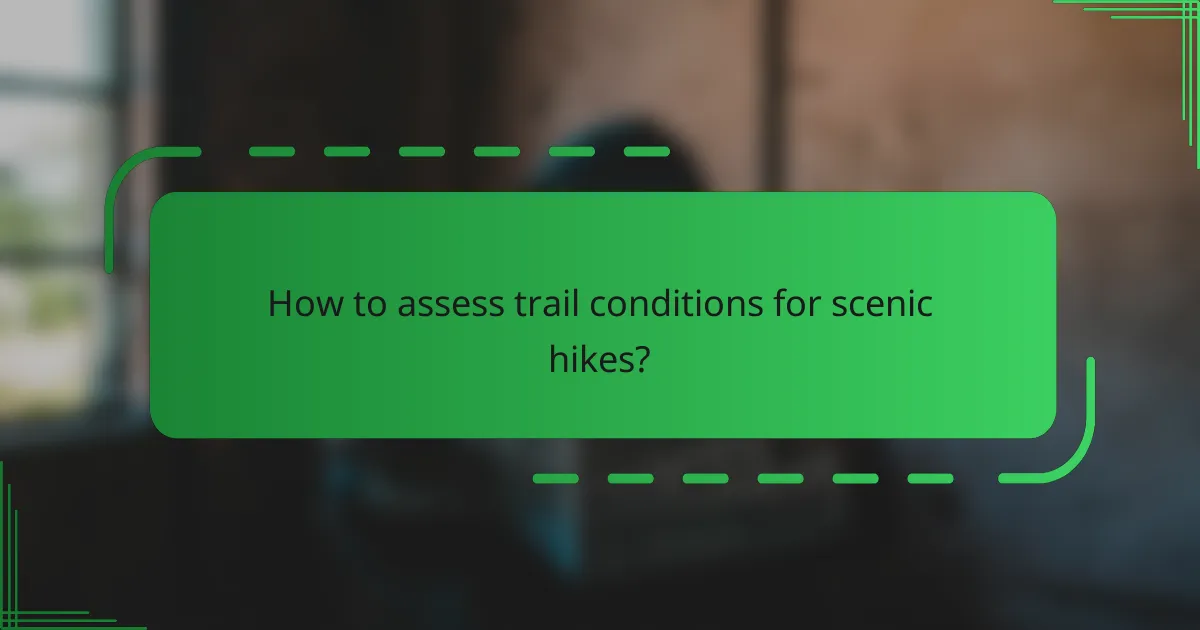
How to assess trail conditions for scenic hikes?
To assess trail conditions for scenic hikes, check for updates on trail status, weather conditions, and any hazards that may affect your experience. This ensures you are well-prepared and can make informed decisions about your hiking plans.
Check local park websites for updates
Local park websites are a reliable source for the latest information on trail conditions. They often provide updates on closures, maintenance work, and weather impacts that could affect your hike.
Look for sections dedicated to trail conditions or alerts. Many parks also offer contact information for visitor centers, where you can call for real-time updates.
Use trail condition apps like AllTrails
Trail condition apps, such as AllTrails, allow hikers to access user-generated reports and photos, giving you a clearer picture of current trail conditions. These platforms often include information on recent weather, trail hazards, and user experiences.
When using these apps, check the date of the last update to ensure the information is current. Engage with the community by reading comments and reviews to gauge the trail’s condition before you head out.
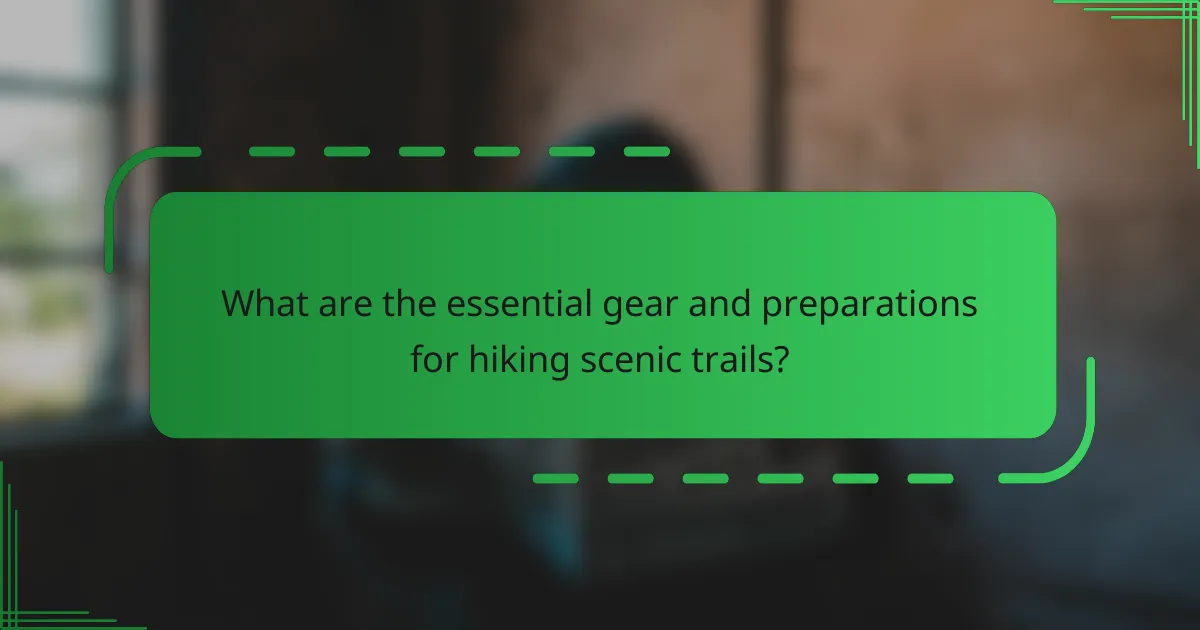
What are the essential gear and preparations for hiking scenic trails?
Essential gear and preparations for hiking scenic trails include appropriate footwear, navigation tools, and a good understanding of trail conditions. Proper preparation ensures safety and enhances the overall hiking experience.
Footwear: Trail running shoes vs. hiking boots
Choosing between trail running shoes and hiking boots depends on the terrain and personal preference. Trail running shoes are lightweight and provide good traction, making them suitable for well-maintained paths, while hiking boots offer more support and protection, ideal for rugged or uneven trails.
When selecting footwear, consider the trail conditions. For wet or rocky terrains, a sturdy hiking boot with waterproof features may be beneficial. In contrast, for dry and smooth trails, trail running shoes can enhance speed and comfort.
Always ensure a proper fit to avoid blisters and discomfort. It’s advisable to break in new footwear before embarking on longer hikes.
Navigation tools: Maps and GPS devices
Effective navigation tools are crucial for hiking scenic trails. Traditional paper maps provide a reliable backup, while GPS devices offer real-time tracking and route guidance. Both tools have their advantages and should be used in conjunction.
When using GPS devices, ensure they are fully charged and have the necessary maps downloaded. Familiarize yourself with how to use them before hitting the trail. For paper maps, learn how to read topographical features and plan your route accordingly.
Always carry a physical map, even if you rely on a GPS, as signal loss can occur in remote areas. A compass can also be a valuable addition to your navigation toolkit.

How do weather conditions affect hiking trails?
Weather conditions significantly influence the safety and enjoyment of hiking trails. Factors such as rain, temperature, and wind can alter trail conditions, impacting both the terrain and the hiker’s experience.
Impact of rain on trail safety
Rain can create slippery and muddy trails, increasing the risk of falls and injuries. Trails that are prone to erosion may become hazardous when wet, making it essential to assess trail conditions before heading out.
Hikers should avoid trails during heavy rainfall or immediately after, as waterlogged paths can lead to dangerous conditions. Checking local weather forecasts and trail reports can help determine if it’s safe to hike.
Temperature considerations for hiking
Temperature plays a crucial role in hiking comfort and safety. Extreme heat can lead to dehydration and heat exhaustion, while cold temperatures can increase the risk of hypothermia. It’s important to dress appropriately and stay hydrated, regardless of the season.
For warm weather hikes, aim to start early in the morning or later in the evening to avoid peak heat. In colder conditions, layering clothing and monitoring wind chill can help maintain body temperature. Always be prepared for sudden weather changes, especially in mountainous areas.

What are the most popular scenic hiking trails in national parks?
The most popular scenic hiking trails in national parks offer breathtaking views, unique landscapes, and varying levels of difficulty. These trails often feature stunning waterfalls, panoramic vistas, and diverse ecosystems, making them ideal for both casual hikers and seasoned adventurers.
Angels Landing: Zion National Park
Angels Landing is one of the most iconic hikes in Zion National Park, known for its challenging terrain and spectacular views. The trail spans about 5 miles round trip and includes a steep ascent with chains to assist hikers on the final section. It’s recommended for experienced hikers due to its exposure and elevation gain of over 1,400 feet.
Before embarking on this hike, check for any permit requirements, as they may be necessary during peak seasons. The best time to hike Angels Landing is in the spring or fall when temperatures are milder and the crowds are smaller.
Bright Angel Trail: Grand Canyon National Park
The Bright Angel Trail is a well-maintained path that descends into the Grand Canyon, offering stunning views and a variety of landscapes. This trail is approximately 9.5 miles one way to the Colorado River, making it a challenging but rewarding hike. Hikers should be prepared for significant elevation changes and varying weather conditions.
Water stations are available at certain points along the trail, but it’s crucial to carry enough water, especially during the hotter months. Plan your hike early in the day to avoid the midday heat and consider starting your journey in the cooler months for a more comfortable experience.

What are the emerging trends in scenic hiking experiences?
Emerging trends in scenic hiking experiences focus on enhancing accessibility, sustainability, and technology integration. Hikers increasingly seek trails that offer breathtaking views, unique natural features like waterfalls, and improved trail conditions.
Waterfalls as Key Attractions
Waterfalls are becoming major highlights on hiking trails, drawing enthusiasts who appreciate their beauty and tranquility. Trails that feature waterfalls often provide opportunities for photography, picnicking, and relaxation, enhancing the overall hiking experience.
When planning a hike to a waterfall, consider the season, as water flow can vary significantly. Spring and early summer typically offer the most impressive displays, while late summer may see reduced water levels.
Scenic Views and Vantage Points
Scenic views are a primary motivator for many hikers, with trails that lead to panoramic overlooks gaining popularity. These vantage points not only provide stunning landscapes but also create perfect spots for rest and reflection.
To maximize your experience, research trails known for their viewpoints and check recent reviews for trail conditions. Popular trails may require permits or have specific visiting hours, so plan accordingly.
Trail Conditions and Maintenance
Trail conditions are crucial for safety and enjoyment, prompting increased attention to maintenance and accessibility. Many hiking organizations are adopting sustainable practices to ensure trails remain in good shape while minimizing environmental impact.
Before heading out, check local resources for trail conditions, including any alerts for closures or maintenance work. Consider using apps that provide real-time updates on trail status to ensure a safe and enjoyable hike.



